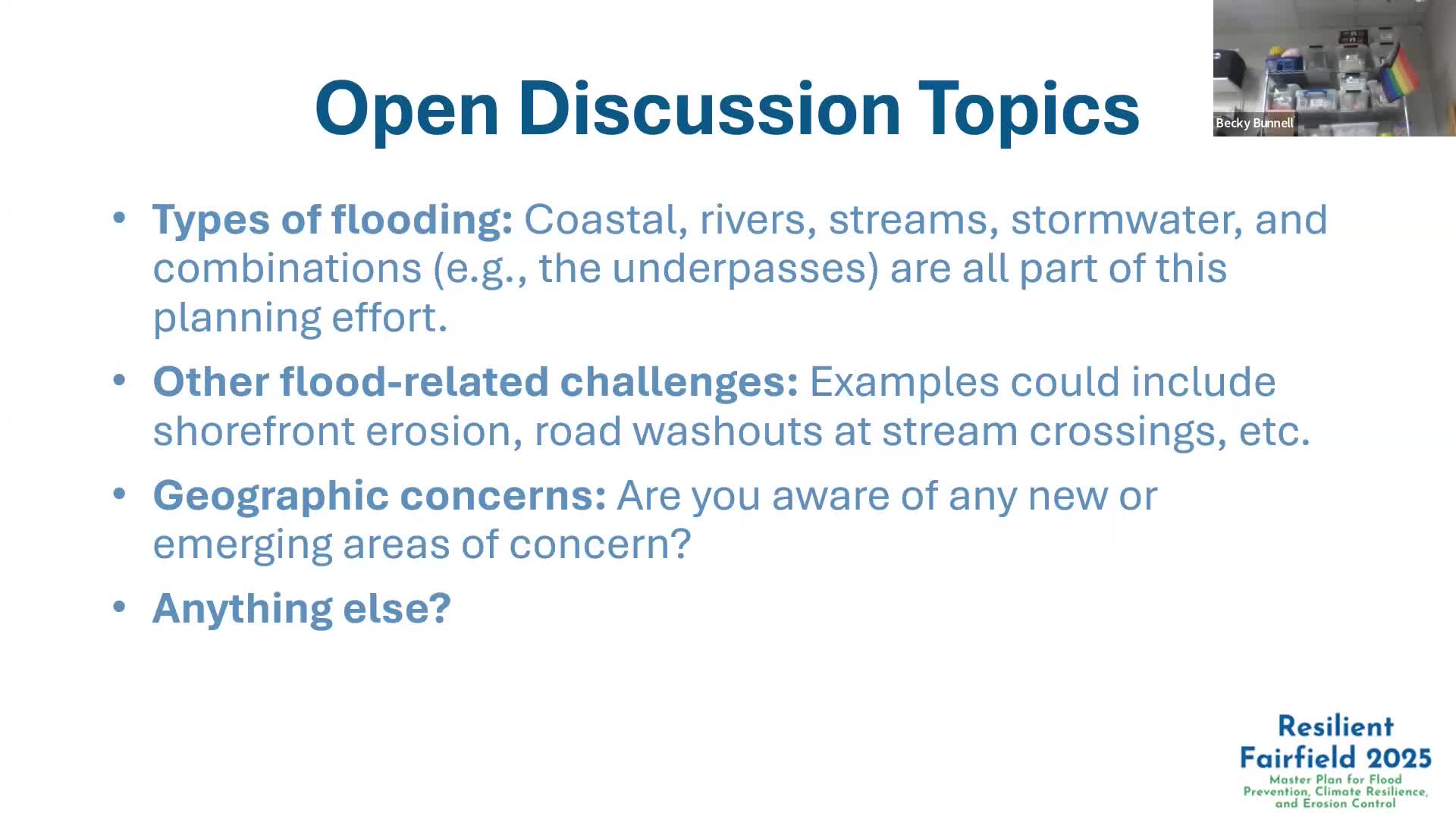Fairfield residents and staff debate limits of large coastal defenses; retreat and property buyouts discussed as long‑term options
March 02, 2025 | Fairfield, Fairfield, Connecticut
This article was created by AI summarizing key points discussed. AI makes mistakes, so for full details and context, please refer to the video of the full meeting. Please report any errors so we can fix them. Report an error »

Residents on Fairfield’s shore and town staff discussed coastal flood options, with officials saying large, town‑wide sea walls to eliminate all coastal flooding are financially and practically unrealistic.
A resident who has lived on Fairfield Shore for 40 years urged engineers to “come over and spend some time with you” to correct misconceptions in past studies about where coastal water comes in and whether some proposed building‑scale protections are appropriate. The resident said much of the coastline floods as a system, not just individual buildings.
Town staff referenced a 2019 Army Corps of Engineers analysis that estimated the level of protection needed to eliminate coastal flooding up to the 500‑year event would require extensive walls and had an estimated price tag of about $547 million, with the town’s share about one third—an outcome staff said they do not consider viable. “We’re not going to protect against a Category 2 or Category 3 storm,” a town official said, noting the town’s preference is to set a financially realistic protection target (staff identified elevation 12 as a planning benchmark for certain coastal work).
Residents raised retreat and acquisition as a concept. One speaker recalled a Connecticut town ordinance from the 1980s that offered to purchase waterfront properties at a fixed price when owners moved out, eliminating structures from the shoreline over time. Town staff said Fairfield already pursues opportunistic land acquisitions in floodplain or conservation areas but that large‑scale buyouts require a dedicated funding program and FEMA buyout timelines and procedures can be slow.
Why this matters: coastline protection implicates large infrastructure, municipal finances and private property values. Staff emphasized a staged, prioritized strategy that fills “gaps” in protection where feasible and focuses on protecting critical infrastructure rather than preventing all private‑property damage.
Next steps: consultants will examine coastal and riverine scenarios and propose concept designs and cost estimates; staff requested resident engagement, offered site visits and asked residents to send photos and recorded observations to improve the accuracy of modeling and proposed solutions.
A resident who has lived on Fairfield Shore for 40 years urged engineers to “come over and spend some time with you” to correct misconceptions in past studies about where coastal water comes in and whether some proposed building‑scale protections are appropriate. The resident said much of the coastline floods as a system, not just individual buildings.
Town staff referenced a 2019 Army Corps of Engineers analysis that estimated the level of protection needed to eliminate coastal flooding up to the 500‑year event would require extensive walls and had an estimated price tag of about $547 million, with the town’s share about one third—an outcome staff said they do not consider viable. “We’re not going to protect against a Category 2 or Category 3 storm,” a town official said, noting the town’s preference is to set a financially realistic protection target (staff identified elevation 12 as a planning benchmark for certain coastal work).
Residents raised retreat and acquisition as a concept. One speaker recalled a Connecticut town ordinance from the 1980s that offered to purchase waterfront properties at a fixed price when owners moved out, eliminating structures from the shoreline over time. Town staff said Fairfield already pursues opportunistic land acquisitions in floodplain or conservation areas but that large‑scale buyouts require a dedicated funding program and FEMA buyout timelines and procedures can be slow.
Why this matters: coastline protection implicates large infrastructure, municipal finances and private property values. Staff emphasized a staged, prioritized strategy that fills “gaps” in protection where feasible and focuses on protecting critical infrastructure rather than preventing all private‑property damage.
Next steps: consultants will examine coastal and riverine scenarios and propose concept designs and cost estimates; staff requested resident engagement, offered site visits and asked residents to send photos and recorded observations to improve the accuracy of modeling and proposed solutions.
View full meeting
This article is based on a recent meeting—watch the full video and explore the complete transcript for deeper insights into the discussion.
View full meeting
